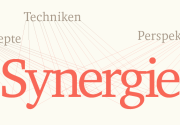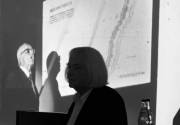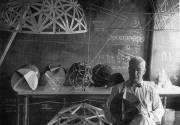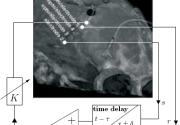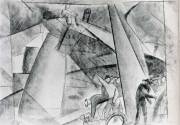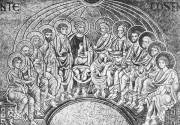Sidebar
features on synergy
Participants and network partners of the SynergyWissen Forum reflect on the numerous concepts of synergy in the natural sciences and humanities, as well as in art and technology. Their explorations of the concepts' historical background, disciplinary applications, current contextual implications, and their future potential are documented in text, audio and video.
© 2011-2018 Forum SynergieWissen ZfL Berlin and the authors. All rights reserved. The usual copyright regulations apply.
feature gallery
synergiefeatures
SynergyFeature01: Synergy – From Term to the Figuration of Knowledge
Synergetic principles are at play when self-organizing systems generate new qualities. Aristotle’s famous saying, “The whole is greater than the sum of its parts” applies to Synergy. Theologians, architects and physicists alike rely on this notion. The concept of Synergy (from the Greek “working together”) has developed in various constellations throughout the history of science. In the transferal between the different disciplines, the concept’s cultural, scientific and aesthetic semantics have consolidated into a figure of knowledge... more...
SynergyFeature02: Synergy in Art and Construction
Tatjana Petzer, Linda Pelchat and Anar Imanov

These days Synergy is a multifaceted concept and operative model in the visual arts and architecture. Underlying it are holistic conceptions of the emergent cooperation between parts, the interaction between internal and external, as well as the integrative energies of the arts, which in turn rely upon the philosophy of nature, theories of knowledge, or religion. Since the mid-1960s, if not earlier, the concepts of Synergy, Syntopia and synérgeia developed into a programmatic field for artists and designers... more...
SynergyFeature03: Preschool of the Synergetic. Buckminster Fuller’s Teachings of the cooperation/interaction more geometrico
The word “Synergy” has found broad use in the last third of the 20th century largely due to the initiative of the American inventor and design theorist R. Buckminster Fuller. His coupling constructions, spatial structures, and tensegrity structures were unexpected and surprising, providing more support and strength while being more lightweight, qualities that could not be achieved under the classical static model of calculation. These constructions and structures were all based on a geometry that Fuller first referred to as “energetic”, then “energetic-synergetic”, and finally “Synergetics”.... go to audio...
SynergyFeature04: Synergy or Totality? Visions of Spherical Construction, Planning Strategies, Global Networks
Is my cultural history of spherical constructions as visions of political and medial cults of totality since 1789 compatible with Richard Buckminster Fuller’s definition of Synergy? Where might the connections lie between Fuller’s synergetic universe with its geodesic constructs and Jacobin ideas about spherical constructions? ....more...
SynergieFeature05: Buckminster Fuller’s School of Synergetics
R. Buckminster Fuller’s Synergetics is designed to be a cure against world’s most severe problems: over-specialization in the sciences and the inequitable distribution of wealth. Like its prelude, Ludwig von Bertalanffy’s General System Theory, Fuller’s Synergetics refers to a supposed superstructure of systems, a concept of wholeness to be found in all fields of sciences, whether physics, biology, psychology or social sciences. Apparently, he is not the only 20th-century thinker who oscillates between systems theory and cosmology...more...
SynergyFeature06: Form Follows Science: A Geodesic Project in the Giant Mountains
The construction conditions on the mountain’s summit were subject to time restrictions due to the harsh climate, and the transport of materials was only possible through the use of cable cars and helicopters. For this reason, a geodesic dome was selected for the construction of the main building. Providing the largest possible capacity over the smallest surface, the dome promised a minimal loss of heat, as well as offering great aerodynamic and static properties. ...more...
SynergyFeature07: Synergy as Symbiosis. Comrades, Agents, Cycles. The Example of Rhizobiaceae
Three players – aka, comrades or agents – take part in this well-known and agricultural symbiosis: namely, a plant family, a bacterial species, and a chemical element. The symbiosis operates in synergetic cycles, that is to say, in biogeochemical processes of planetary proportions. Here the production of fertilizers takes on historical implications: Symbiosis stands in the way of industrial processing. The fundamental question concerning an energetic future without or a synergetic future with “companion species” looms....more...
SynergieFeature08: The Biosphere and Noosphere: Vladimir Vernadsky and Teilhard de Chardin
 Jesse P. Hiltz und George Levit
Jesse P. Hiltz und George Levit
At the beginning of the 20th century, Vladimir Vernadsky and Pierre Teilhard de Chardin created theories in which the concepts of the biosphere and the noosphere played an important role. They shared similar bodies of empirical data, general methodological premises and concepts, and comparable theoretical objectives. Both scientists left the boundaries of purely descriptive natural science and tried to create all-embracing and “worldview-building” theoretical systems including elements of philosophy, social sciences and authorized interpretations of evolutionary theory. Yet, each of their resultant biosphere/noosphere theories describe two different theoretical worlds...more...
SynergyFeature09: Noosphere – SynEnergies’ very long range
Thought in itself, according to Vernadskij, is not a form of energy. But in the era of fossil fuels, thinking is clearly in a position to unleash energy from the deepest historical layers of the biosphere. This view of planetary time attracted my interest in fossil raw materials and also captured Vernadskij’s attention. Even the history of industrialization provides access to an understanding of this planetary period. The modern power of fossils became all the more apparent in light of the two World Wars....more...
SynergieFeature10: Creode
In his book The Strategy of the Genes, the biologist Conrad Hal Waddington (1957) claims that: “Oddly enough, I can discover no technical word meaning a pathway of change which is equilibrated in the sense that the system tends to return to it after disturbance.” He hoped to find such a word in the kinetics or cybernetics of polyphasic systems. His search appears to have been unsuccessful, for Waddington instead coined the neologism “creode” to define this property. A creode represents a temporal sequence of conditions within a system, which takes its form in a developmental pathway along which the system traverses space and time. The system is defined through the interaction of its individual pieces. ...more...
SynergyFeature11: Autopoesis and Synergetics – Two Different Concepts of Self-Organization
The theory of autopoiesis and the theory of Synergetics are often understood as synonymous with self-organization theories, despite there being significant differences between the two that concern the conceptual understanding of “self-organization.” Autopoiesis theory draws upon the self-production of already existing living systems, while Synergetics fundamentally asks questions of the origin and evolution of ordered conditions. Autopoiesis takes place in a state of equilibrium, while synergetic processes presuppose critical states of imbalance ...more...
SynergyFeature12: Physics of the Migraine
Theoretical physics and neurology, at first two seemingly independent fields, come together in the concept of dynamic diseases, a concept that was purposefully developed as antithetical to the concept of genetic diseases. In order to take full advantage of the possibilities of modern medicine, both should be understood as complementing and necessarily relying upon each other. Under the term dynamic diseases we mean those diseases that – with regard to symptoms – follow specific temporal processes. That is to say, symptoms which follow a specific rhythm. In the framework of bifurcation theory, mathematical models may be used to classify the points of rhythmic transition, for example, from a healthy to an unhealthy condition. Hidden behind this is the hope that such a mathematical understanding may lead to new therapeutic approaches....more...
SynergyFeature13: Synergy: On the History of an Elementary Concept at the Juncture of Religion and Medicine
As a social practice, medicine was shaped by synergetic maxims and holistic ways of thinking more so than by anything else. Historically speaking, this influence was evident in a compromise, whereby the healing effect of medicine was ascribed to the combination of the art of medical practice and the power of the Holy Spirit, the secular use of medicinal drugs and the vitalistic ideas of Georg Ernst Stahl. Since ancient times these concepts of Synergy have consistently reappeared in new conceptual configurations, and, from a history of ideas perspective, came to be described by Arthur Lovejoy as elementary concepts....more...
SynergieFeature14: Can We Consider Synergetics as a New Naturphilosophie?
 von Elena Knjazeva
von Elena Knjazeva
Synergetics provides us with the knowledge of behavior of complex nonlinear systems in nature, society and in the human consciousness. The theory teaches us how we can comprehend this complexity and cope with it. In other words, it pretends to universalism. The question arises what is the difference between synergetics and the known systems of natural philosophy which consider nature in its integrity when resting upon concepts elaborated in natural sciences? Can we consider synergetics as a natural philosophy of the epoch of the post-nonclassical science? ...more...
SynergyFeature15: The Synergy Concept in Byzantine Philosophy and its Current Uses
The main subject of Byzantine philosophy is not substance in and of itself, but rather its reality, its effects and movements and therefore its existence, through which its essence can also be recognized. Its constitutive axes consist of the teachings of energy and the Synergy concept. Its pre-theoretical basis can be found however in everyday examples. Aphoristically formulated: the Greek pragma is not completely identical to the Latin res. Pragma is the concrete noun of praxis. “Praxis” however, does not mean objectivity, but rather “action”, “doing”, “affecting”, although its original meaning is “permeation”, “penetrate through”. The reality is a dynamic network, connected via the interrelationship of hypostatically expressed effects.... more...
SynergieFeature16: SynergyFeature16: Vladimir Solov’ev’s Synergetic Individualism: The Prayer as Communion with Sophia
The core of orthodox neo-palamism is situated in the teachings of synergism. The conceptualization had certainly distanced itself from the trend to which it actually owes its emergence, namely, that of the Russian sophiology and its founder, Vladimir Solov’ev. In his earlier works he developed the concept, according to which prayer was not only considered the most important form of Synergy, but was also as a technique used to experience God directly, particularly in the form of the mystical experience of divine revelation. ...more...
SynergieFeature17: Why unlock oneself? A new anthropology growing out of the ancient principle of synergy
von Sergej Choružij
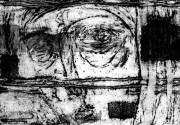
Following the general principles of Orthodoxy, the teachings of Gregory Palamas, a monk from the Holy Mount of Athos, stated that the destination of Man and the fullness of his self-realization represent nothing but the deification of man (theosis), that consists in transcending man’s mode of being: such a change that all energies of the human being unite with Divine energies, and so partake in Divine being. It stated also that, according to the experience of hesychast practice, the necessary condition for theosis is the achievement of synergeia, synergy: a meeting and collaboration, concerted action of all human energies and Divine energy...more...
SynergyFeature18: Synergy, Monism and Ideology in the Context of Russian Modernity
Synergy stands for holistic thought, for the idea of cooperation and unity, which has shaped Russian culture for centuries. To this end it is worthwhile to explore the semantically equivalent codes that link certain contexts that may also be understood as doppelgängers of “Synergy”. “Monism” and “Ideology” appear to represent such equivalents, although they exhibit significant shifts in meaning (from their emergence in unified impact to their emergence in the convergence of sight and thought)....more...
SynergyFeature19: Synergy through Grafting. Aleksandr Bogdanov’s Contributions to Philosophy, Art and Medicine
To what extent can Aleksandr Bogdanov truly be considered a Synergist? This question confronts us with a systematic problem which would cause some historians to not even ask it – the problem being that Bogdanov never used the concept. He did however continuously refer to Aristotle’s saying that the whole is greater than the sum of its parts, through which he developed a philosophy explaining how everything is related to everything. He also presented the world as a whole that may be optimized once one has comprehended it. I now want to try to understand Bogdanov’s philosophy as synergetic and thereby demonstrate that such an understanding would be more effective if one looks at his writings (again, in which the concept does not appear) alongside his practical work (in which the structures reveal themselves more definitively)....more...
SynergyFeature20: “The Word of God is Synergetic”. Pavel Florenskij’s Cultural Theory of Cooperation
According to the Russian mathematician and priest Pavel Florenskij, the power of the word – and particularly the name – can be seen in the divine workings in human language and through human participation in the energy of God. The spoken name had a magical influence on the outside world and a mystical one on the inner world. Accordingly, the performative speech act set energy free, which enabled mankind’s participation in the work of divine creation, thereby enabling synergeia. ...more...
Synergiefeature21: Look beyond the Horizon (about reverse Perspective)
von Gor Čachal

It turns out that objects situated beyond the horizon, in the supernatural world, can only be observed contemplatively, in reverse perspective. The return of artists to direct linear perspective during the Renaissance was only a loss on their part of the desire to look beyond the horizon. In essence, it was a rejection of interest in the Divine world, and a step backwards in spiritual development. It is thus clear why Pavel Florensky argued that direct perspective and reverse perspective are the antipodes of artistic thinking...more...
SynergyFeature22: Velimir Chlebnikov’s Imaginary Synergy
With his ”Gamma of the Budetljanin“, the Russian futurist Velimir Chlebnikov designed a mathematical, astronomic, and historical metric which represents the cooperation between events and processes in literature as well as the synchronization of these oscillations out of space and time. Energetic structures and correlations are made visible through the study of rhythm that binds these dimensions. These blend together in a global synergetic system, in one single oscillation of cosmic proportions....more...
SynergyFeature23: Telling and Salvation: Martin Buber’s Early Interpretation of Hasidism
Martin Buber’s works on the mystical movement of the Eastern European Jews and their masters, the “tzaddikum,” were best sellers of the fin de siècle. His writings brought an entire continent’s religious cultural practices to the assimilated Western European Jews. Buber formulates a general and practical theology of redemption on the basis of Hasidism which uses narrative as its medium, from the longer account that Buber “retold” to the pithy words of the charismatic, that mediator between God and men standing before his congregation....go to audio...
SynergieFeature24: Engineering applications of self-organization and pattern formation principles
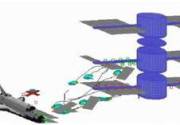 von Jens Starke
von Jens Starke
Self-organized modular approaches proved in nature to be robust and optimal and are therefore
also a promising strategy in engineering. The potential of self-organization and pattern formation
principles in engineering will be demonstrated for future concepts of flexible and modular
manufacturing processes. In particular, a model of flexible manufacturing is considered which is
based on time-dependent robot-target assignment problems where robot teams have to serve
manufacturing targets in an optimal way. ...go to audio...
SynergyFeature25: Intelligent Systems. From the Evolution of the Brain to Robotic and Artificial Intelligence
By the time of the Renaissance, if not earlier, “life as a machine” and “artificial intelligence” had become influential metaphors. Are there laws through which evolution can be calculated, explained and forecasted? This development in systems biology can best be seen in new methods from the fields of biomathematics, biophysics, and bioinformatics. The main issue deals with cyber-physical systems as socio-technical systems, in which nature, technology, and society merge. Which risks and opportunities are associated with these complex infrastructures of the global earth system? How do they allow themselves to be regulated, so as not to be overrun by a “blind” socio-technological coevolution?...go to video...
SynergyFeature26: About the “Cooperation” in Chemistry
 Robert Kretschmer
If one examines the terms cooperation and Synergy from the point of view of chemistry, one might be tempted to ask: which parts actually work together or interact on some level? The answer: with reactions it is the chemical molecules, within these molecules it is the atoms, and within the atoms it is the atomic core that define the properties of the system in question. If one follows this line of thought, chemistry, at least in its general form, can be cooperative. Everything is mutually interdependent. ...more...
Robert Kretschmer
If one examines the terms cooperation and Synergy from the point of view of chemistry, one might be tempted to ask: which parts actually work together or interact on some level? The answer: with reactions it is the chemical molecules, within these molecules it is the atoms, and within the atoms it is the atomic core that define the properties of the system in question. If one follows this line of thought, chemistry, at least in its general form, can be cooperative. Everything is mutually interdependent. ...more...

